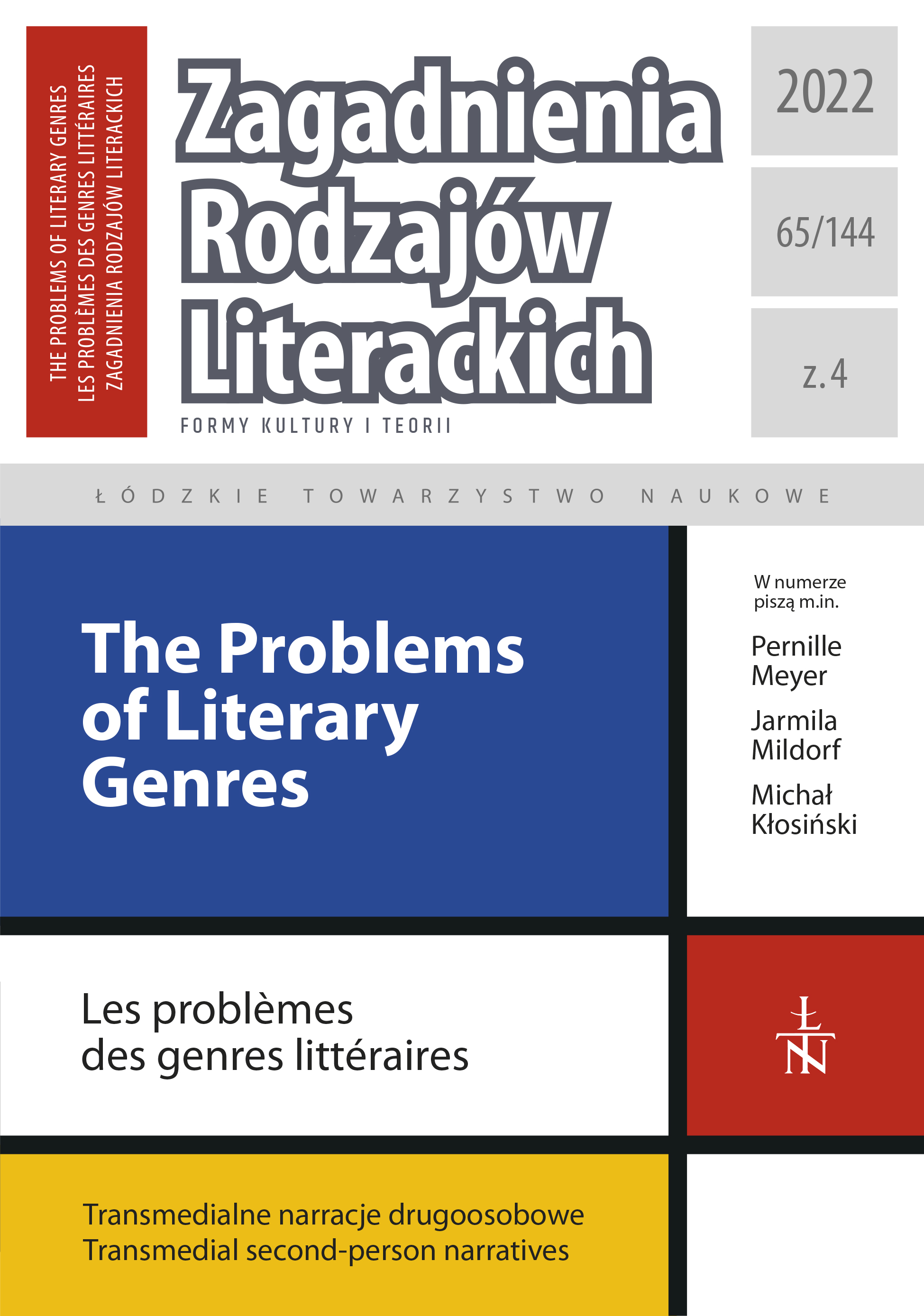„Rzuć K8 na inicjatywę”, czyli o narracji drugoosobowej w grach fabularnych
DOI:
https://doi.org/10.26485/ZRL/2022/65.4/9Słowa kluczowe:
second-person narration, tabletop role-playing game, RPG, Game MasterAbstrakt
The aim of the article is to present the phenomenon of using the second-person narrative in tabletop role-playing games. Despite its ambiguous status in literary projects, the dyadic narrative is the basic component of the phenomenon of pen-and-paper RPGs. In the introduction, the author briefly introduces the specificity of text-based narrative games and the history of their creation. Then the most popular systems, such as Dungeons & Dragons or Vampire: The Masquerade, were characterized, as well as examples of games created in Poland. To illustrate the phenomenon, official manuals, and recordings of sessions of the most popular Polish artists published on YouTube were used. When discussing examples of second-person narration, the author draws attention to its occurrence in guides and in the statements of the player functioning as the Game Master. The Game Master is a specific narrator of heroes’ adventures, who in his action smoothly moves between different types of narratives (first, second and third person): he describes the scenery and actions of NPCs and creatures, constructs statements of characters not guided by other participants of the session, but also comments on the actions and commands of player-created heroes. It is precisely in this last type of activity that the dyadic narrative is extremely important. In the statements of the Game Master, it manifests itself primarily as a commentary on the actions of the characters, the continuation of the plot after the actions and statements of the players, and when consulting the heroes’ further actions, but also serves technical communication related primarily to the mechanics of throwing polyhedral dice. The use of a second-person narrative in RPGs primarily contributes to increasing the immersion, the involvement, and the sense of interactivity between players.
Liczba pobrań
Bibliografia
Blacha Marcin, Oracz Michał, Baryłka Marcin, Trzewiczek Ignacy (2003), Neuroshima. Posapokaliptyczna gra fabularna, Wydawnictwo Portal, Gliwice.
Cyberpunk 2020. Edycja polska (1995), przeł. J. Brzeziński, T. Jasinkiewicz, Copernicus, Warszawa.
DelConte Matt (2003), Why „You” Can›t Speak: Second-Person Narration, Voice, and a New Model for Understanding Narrative, „Style” nr 37.
Dungeons & Dragons. Player’s Handbook. Podręcznik gracza — edycja 5. (2020), przeł. L. Mikolcz, T. Mikolcz, T. Chmielik, Rebel, Gdańsk.
Figus Jakub Mateusz (2017), Wybrana leksyka uczestników narracyjnych gier fabularnych (RPG), „Homo Ludens” nr 1(10).
Gospoda RPG (2021), Wiatry Targos. Ekspedycja poszukiwawcza 1/3, www.youtube.com/wa tch?v=D9zxv6dwcb8&list=PL2XN9jyeCsgB1zdopQnT7RkdW4MJGk87i [dostęp: 20.06.2022].
Herbut Patrycja (2017), Różnorodność systemów, światów przedstawionych i onimii w Role-Playing Games, „Acta Humana” nr 8.
Maj Krzysztof Marek (2015), Czas światoodczucia. Imersja jako nowa poetyka odbioru, „Teksty Drugie” nr 3.
Marszalik Michał, Nowak-Kreyer Maciej, Studniarek Michał, Kreczmar Tomasz (2001), Wiedźmin. Gra wyobraźni, MAG, Warszawa.
Matyka Marzena (2014), Socjolekt uczestników klasycznych gier fabularnych jako profesjolekt, „Homo Ludens” nr 1(6).
Mildorf Jarmila (2012), Second-Person Narration in Literary and Conversational Storytelling, „Storyworlds: A Journal of Narrative Studies” nr 4.
Oficjalny kanał Critical Role w serwisie YouTube, www.youtube.com/c/criticalrole/about [dostęp: 20.06.2022].
Petrowicz Marcin (2015), Mechaniki tworzenia postaci, „Homo Ludens” nr 2(8).
Rembowska-Płuciennik Magdalena (2017), O przechodzeniu na ty… Narracja diadyczna wśród literackich reprezentacji świadomości bohatera [w:] (W) sieci modernizmu. Historia literatury — poetyka — krytyka, red. A. Kluba, M. Rembowska-Płuciennik, Instytut Badań Literackich PAN, Warszawa.
RPG [hasło w:] Słownik języka polskiego PWN, www.sjp.pwn.pl/szukaj/RPG.html [dostęp: 17.05.2022].
Sabat Maciej (2003), Krótka historia gier fabularnych, „Dekada Literacka” nr 7–8.
Smoleńska Olga (2009), Najnowsze trendy w turystyce eventowej. Gry fabularne i wydarzenia związane z fantastyką i technologią XXI wieku, „Turystyka kulturowa” nr 8.
Szeja Jerzy Zygmunt (2004), Gry fabularne — nowe zjawisko kultury współczesnej, RABID, Kraków.
Szymanik Anna, Kostrzewski Michał (2012), Gry narracyjne jako metody i narzędzie w nauce, „Forum Dydaktyczne” nr 9–10.
To ja go tnę! (2019), Zniknięcie Abigail vol. 1. Sesja RPG Cyberpunk 2020, www.youtube.com/ watch?v=6rf_-pdEQ6s&list=PLXQV7yBcVcXpVwuoIoOrSH9Id8zm_GETS [dostęp: 20.06.2022].
Walczak Radosław Bartosz, Wężowska Joanna (2017), Gry fabularne jako sposób zwiększenia kontroli nad rzeczywistością. Poczucie umiejscowienia kontroli oraz emocjonalność graczy w porównaniu do młodzieży niegrającej, „Homo Ludens” nr 1(10).
Wampir: Maskarada. Podręcznik główny — edycja 5. (2020), przeł. I. Czyż, L. Czyż, Alis.Games, Pszczyna.
Zdunkiewicz-Jedynak Dorota (2008), Wykłady ze stylistyki, Wydawnictwo Naukowe PWN, Warszawa.
Zdunkiewicz-Jedynak Dorota (2014), Remediacja użytkowych gatunków wypowiedzi. Casus: podręcznik [w:] W kręgu zagadnień semantyki i stylistyki tekstu, red. A. Piasecka, I. Blumental, Wydawnictwo Uniwersytetu Łódzkiego, Łódź.







